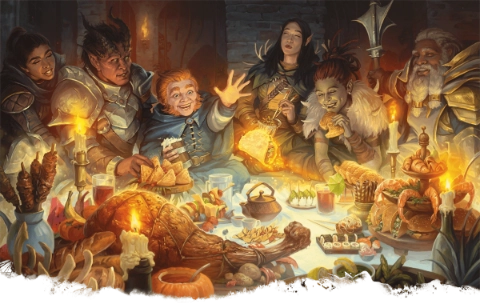The recent artwork depicting the Hero’s Feast spell has sparked a heated debate within the TTRPG community. While some argue that the inclusion of modern dishes like sushi and tacos breaks immersion, others welcome this expansion of the game’s aesthetics to make the setting familiar to more people. However, this debate overlooks a powerful worldbuilding tool: using food to create a deeper sense of culture and tradition in our fantasy worlds.
Food is a universal connector across cultures, and it can be an excellent vehicle for humanizing and adding depth to the communities in your TTRPG settings. This post will explore how to effectively use food descriptions to enhance your worldbuilding, providing concrete strategies and examples to implement in your games.
The Power of Food in Worldbuilding

Food can instantly create a sense of verisimilitude about the communities in your world. It’s not just about what people eat, but the particular styles and traditions behind it, which can suggest a great deal about a culture. Here are some key reasons why food is an effective worldbuilding tool:
- Universal relatability
- Cultural signifier
- Historical context
- Social dynamics
- Environmental indicators
By incorporating food into your descriptions, you can subtly convey information about all these aspects of your world.
Strategies for Using Food in Worldbuilding
1. Describe, Don’t Label
The key to effective food-based worldbuilding is to let the player draw connections to the familiar without explicitly naming real-world dishes. Instead of saying “taco,” describe the dish:
- “Spiced meats nestled in a warm, soft flatbread”
- “Tender chunks of seasoned meat cradled in a folded, griddled cornmeal cake”
- “Sliced cooked vegitables in a rich sauce of light oils and spices, with a spongy bread used to grab and eat the dish.”
This approach allows players to make connections while maintaining the fantasy atmosphere.
2. Use Food to Hint at Cultural Practices
Food preparation and consumption can reveal a lot about a culture. Consider the following examples:
- A culture that values community might have traditions of communal cooking and shared meals
- A nomadic society might favor preserved foods and portable meals
- A hierarchical society might have strict rules about who can eat certain foods
- A society may have particular traditions about the use of animals as food
3. Incorporate Food into Religious or Magical Practices
Food often plays a role in religious rituals and magical practices. Some ideas to consider:
- Sacred plants or animals that are never eaten
- Medicinal plants or animals that are always eaten
- Specific preparations required for magical ingredients
- Fasting or feasting traditions tied to religious observances
4. Use Food to Indicate Social Status
What people eat can say a lot about their place in society. Think about:
- Rare or expensive ingredients reserved for the elite
- “Peasant foods” that become delicacies
- Taboos around certain foods for different social classes
5. Let Food Reflect the Environment
The available food can tell players a lot about the local environment. Consider:
- Coastal regions with abundant seafood
- Arid areas with drought-resistant grains and preserved foods
- Lush forests with a variety of fruits and game meats
- Hot climates using spices and drying techniques for food preservation
- Cold climates relying on smoking, salting, and fermentation for food storage
- Temperate regions developing cheese-making and curing methods for dairy and meat preservation
Implementing Food-Based Worldbuilding
To effectively use these strategies in your game, consider the following steps:
- Create a food profile for each major culture in your world
- List three staple ingredients used in most meals
- Describe common cooking methods, unique tools, or how food is stored
- Note any significant food-related traditions of who can eat, what, and why
- Incorporate food descriptions into your scene-setting
- Describe smells and sounds of cooking in market scenes
- Mention what characters are eating during social interactions
- Highlight an NPCs preferences through how they eat their food (greedy, cautious, supiciously smell every bite, etc)
- Use food as a plot device
- A rare ingredient as a quest item
- Diplomatic incidents over unfamiliar food customs
- Poisoned feasts as a dramatic set-piece
- Encourage player engagement with food
- Ask players what their characters typically eat
- Allow cooking skill checks for mechanical benefits, like helping in negotiations
- Use food preferences as character development opportunities
Conclusion
By thoughtfully incorporating food into your worldbuilding, you can create a richer, more immersive experience for your players. This approach allows you to subtly convey cultural information without resorting to direct real-world analogues or risking the trivialization of actual cultures.
Remember, the goal is to create something new that feels familiar enough to be believable. By sprinkling in these culinary details, you’re not just describing food; you’re hinting at entire cultures and histories that can make your world come alive.
Next time you’re describing a feast in your game, consider how you can use food to paint a picture of your world’s cultures. It’s an excellent way to add depth to your game without breaking immersion.
Resources for Further Exploration
- Mythcreants ep385 - Food in Speculative Fiction podcast
- Food in History Book by Reay Tannahill
- Fantasy Guide to Feasts tumblr by inky-duchess
- The Inn at the Crossroads blog on ficitional foods of all kinds.
These resources can provide inspiration and depth to your food-based worldbuilding efforts. Remember, the key is to use these ideas as springboards for your own creativity, tailoring them to fit the unique aspects of your game world.